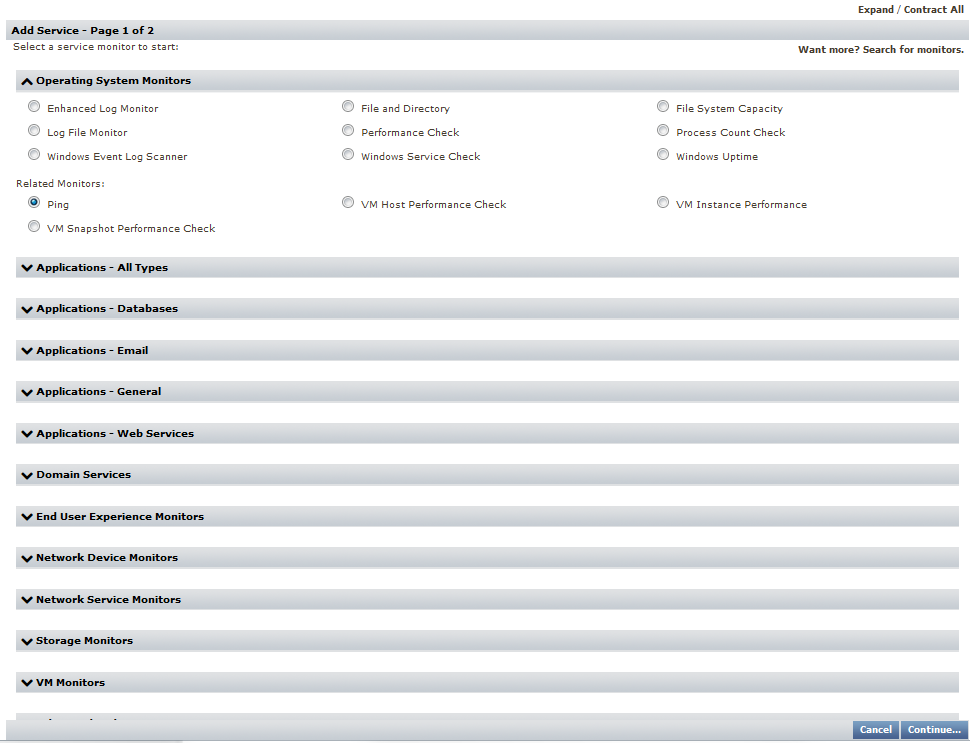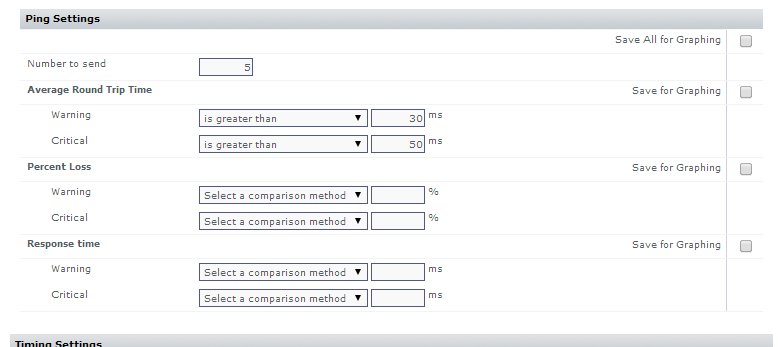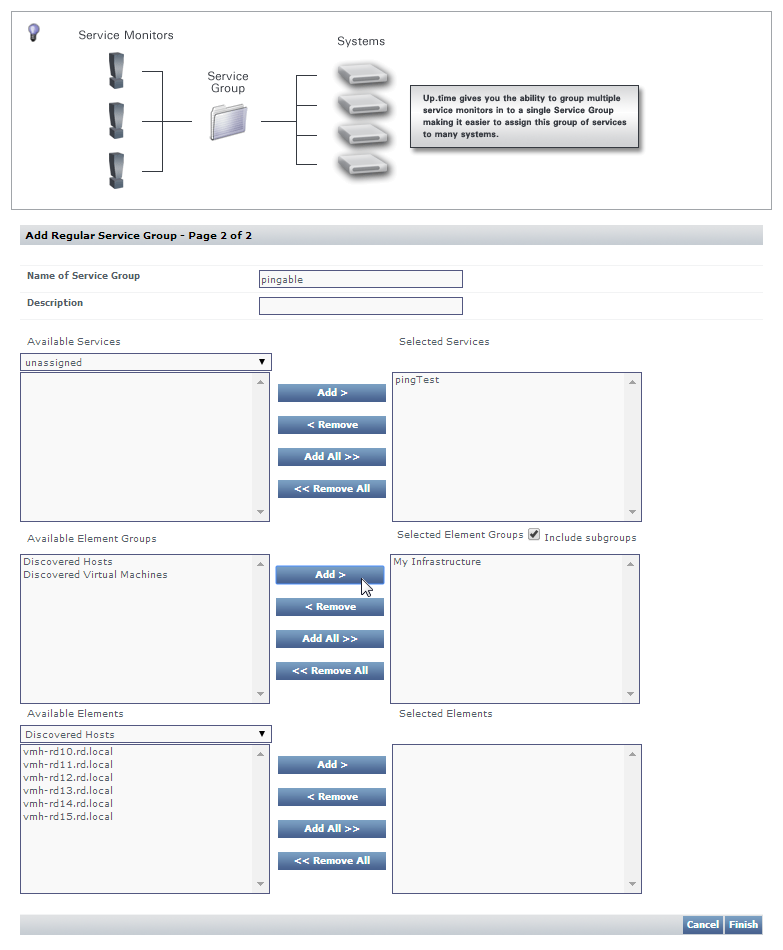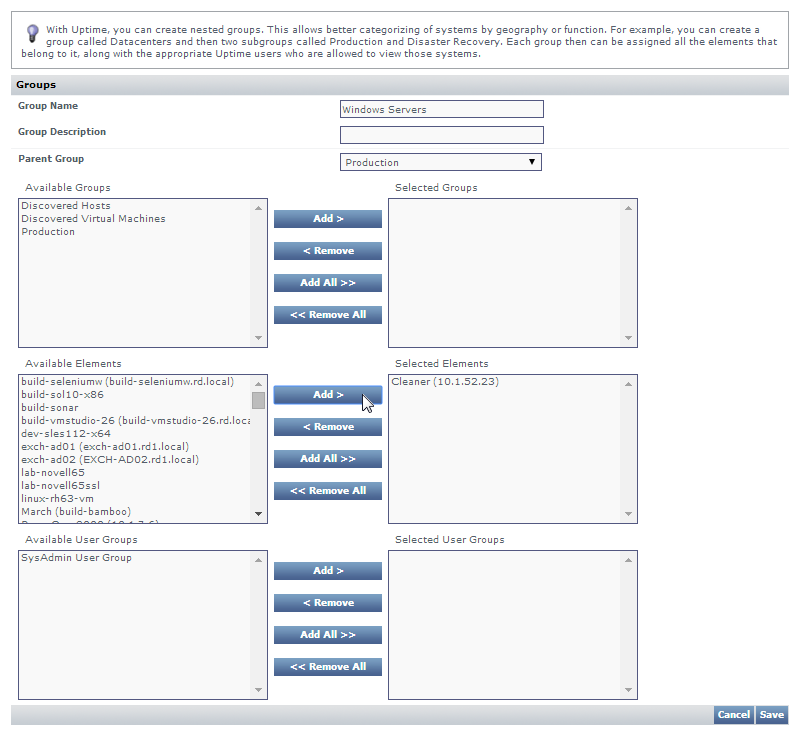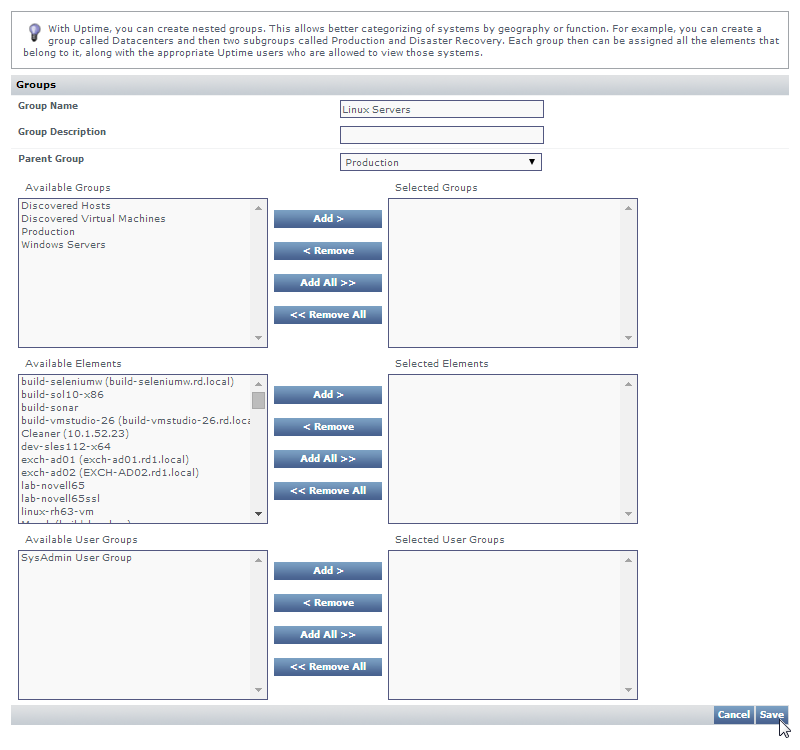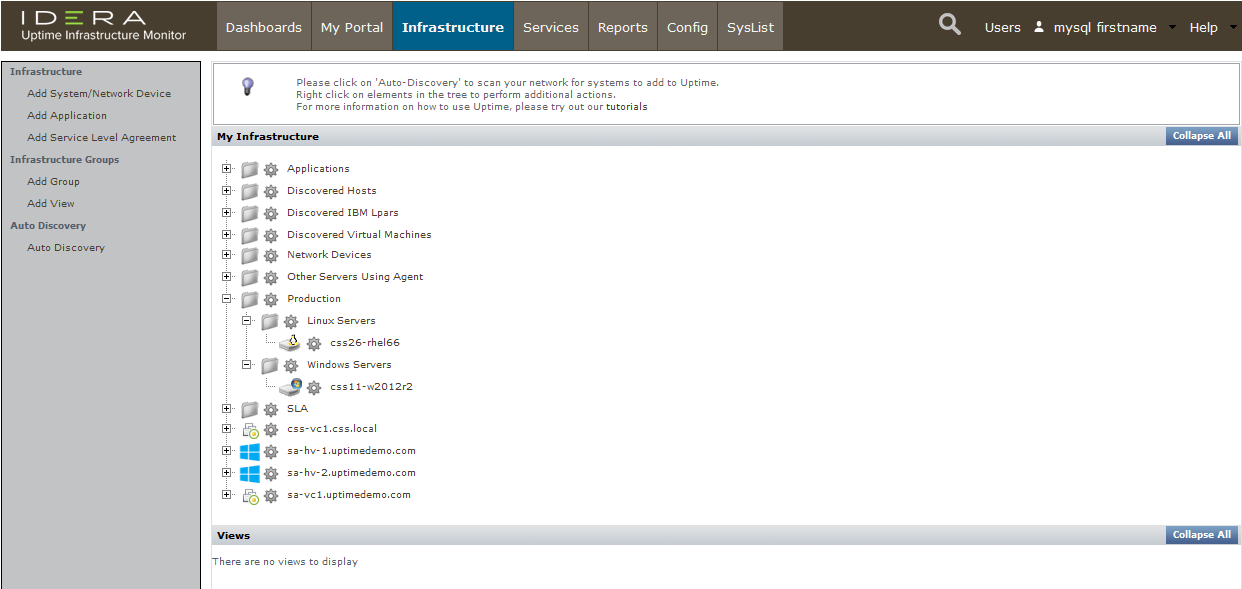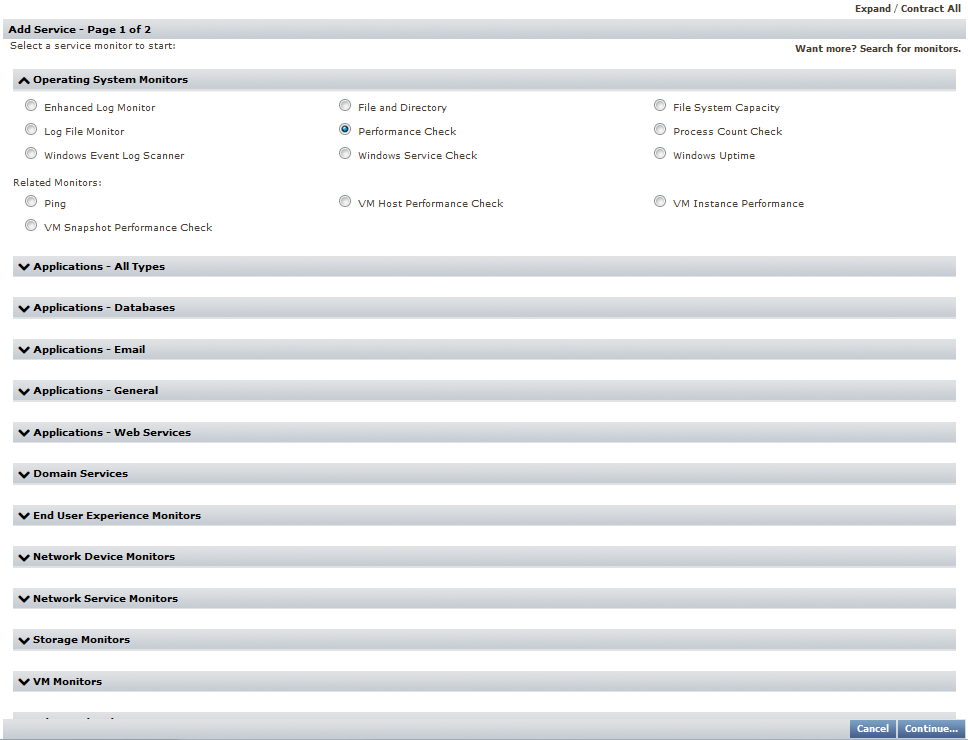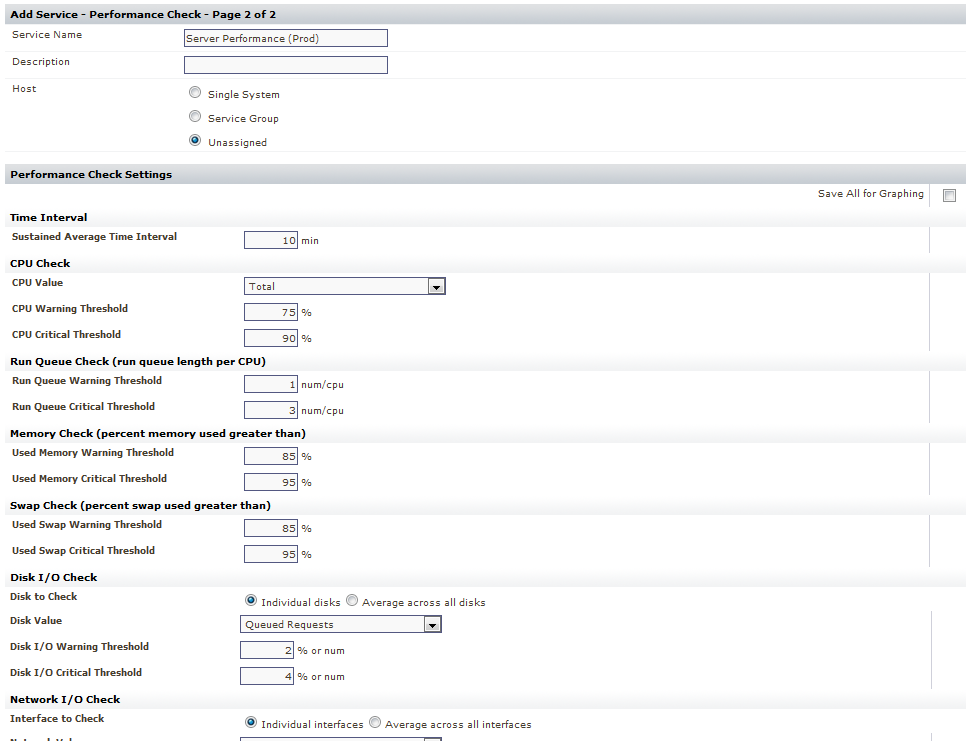...
- Click Services, then click Add Service Monitor in the left pane.
- In the Add Service Monitor pop-up, select the Ping service monitor, and click Continue.
- Provide a Service Name of
pingTest, and make it Unassigned.
Note that this service monitor, as it's being created, can also be assigned to an individual Element (that is, a single system), or a Service Group; let's leave it assigned to nothing for now. - For the sake of completion, let's configure a pair of alert thresholds for the service monitor's Average Round Trip Time:
- warning > 30 ms
- critical > 50 ms
- Click Finish, then click Close Window.
...
- In the left pane, click Add Service Group.
- In the Add Service Group pop-up window, confirm the group type is Regular, then click Continue.
- Give the Service Group a name. In this example, we'll call this group
pingable: Configure the Service Group to include the pingTest service monitor you created earlier in this exercise, and associate it with the My Infrastructure Element Group.
Note title FYI My Infrastructure is always available as an Element Group, as it represents all of your monitored inventory (or, Elements), as shown when you view it in the My Infrastructure panel. The other two groups shown in this example (Discovered Hosts, and Discovered Virtual Machines) were automatically created when you add a VMware vCenter Server as an Element.
- Click Finish, then click Close Window.
In the main UI window, you are taken to your list of Service Groups, of which you now have one:
The list provides a summary of each Service Group. In our case, our group is associated with a single Element Group (and any of its subgroups); it is not directly assigned to any individual Elements; it contains a single service monitor.
...
- Click My Infrastructure to view the inventory you added in the first module:
- Click any Element's gear icon, then in the pop-up menu, click View to display its General Information page.
Since you have associated the Service Group to all Elements (by way of the My Infrastructure Element Group), the service monitor will be attacked to any Element. - In the left pane, click the Services tab to display any services attached to, and monitoring, this Element.
You can see that by creating a Service Group (pingable), and linking it to an Element Group to which this Element belongs (My Infrastructure), this Element now uses this service monitor. Some things to note using the above screenshot:- the pingTest service monitor has a (member) suffix to indicate it is "attached" to this Element via a Service Group, meaning the properties of this service monitor can only be edited at the Service Group level (it is possible to "detach" a service monitor to make it editable at an Element level, but this is not a best practice)
- the pingTest service monitor status may be shown as UNKNOWN because it has recently been added, and a full monitoring interval has not yet passed
- to view how long a monitoring interval is for a particular Element, click its Info tab, then look in the Data Collection section of the General Information page
...
- Click My Infrastructure, then click Add Group in the left pane.
Provide a Group Name of
Production, leaving the other configuration options empty, or at the default value:- Click Save, then click Add Another.
- Provide a Group Name of
Windows Servers, and make the Parent Group the previously created Production group: From the Available Elements list, locate and add your Windows Element.
Note title Note As mentioned at the beginning of this module, it is assumed you have Windows and Linux server Elements in your inventory. If you don't, you can either follow along, substitute these examples with something similar in your current test inventory, or go back and add these types of Elements.
- Click Save, then click Add Another.
- Provide a Group Name of
Linux Servers, and again make Production the Parent Group: Click Save, then click Close Window.
Notice how we did not add your Linux server to the Linux Servers Element group as we were creating it. You can also assign an Element to an Element Group from the perspective of the Element itself.- In the main UI window, locate your Linux server in My Infrastructure.
- Click its gear icon, then click Edit.
- In the pop-up window, change the Element's Parent Group from My Infrastructure, to Linux Servers:
Click Save.
Validation (My Infrastructure)
After adding the Element Groups, in the main UI window, My Infrastructure is displayed. Click to expand the Production group, and the Windows Servers and Linux Servers child groups. Each of these child groups contain one Element.
Structuring your monitored inventory in My Infrastructure not only facilitates Element management for system administrators, but, as the structures are reflected in dashboards, can also be useful for end users.
...
When you are viewing data for one child group, you can move laterally to display a sibling child group by using the drop-down at the end of the breadcrumb trail at the top of the dashboard:
Keeping your monitored inventory well organized has several important benefits including more relevant at-a-glance viewing, logical drill-down paths for investigation, and focused report generation. Element Groups are even more useful when combined with Service Groups, which we will explore a bit more in the next exercise.
| Note | ||
|---|---|---|
| ||
In the sample images above, the gauges and performance graphs are showing more information than you may be seeing on your own Monitoring Station. A data-collection interval is required to have passed before any information is shown; until then, you may see empty graphs such as the following: |
Learn About Inheritance
...
- Click Services, then click Add Service Monitor in the left pane
- In the Add Service Monitor pop-up, select the Performance Check service monitor, and click Continue.
- Provide a Service Name of
Server Performance (Prod), and leave it Unassigned (we are going to create a Service Group for it): - For the sake of the exercise, continue to configure the service monitor will some thresholds, similar to those shown above.
For this module and guide, we won't be making use of any performance checks you define, but feel free to experiment. You can always enter some unrealistically strict thresholds to force alerts, just to see how they appear on the dashboards. - Click Finish, then click Close Window.
Now that we have created a common performance check intended for all your production servers, let's do what we did in the first exercise of this module, and create a Service Group that will include it. - Click Services, then click Add Service Group in the left pane.
- in the Add Service Group pop-up window, confirm the group type is Regular, then click Continue.
- Configure the service group as follows:
- Provide a logical group name such as
Server Availability/Performance (Prod) - From the unassigned group of Available Services, add the Server Performance (Prod) service monitor you created earlier in this exercise.
- Select, from the Available Element Groups, the Production Element Group that you created in the last exercise.
- Ensure the include subgroups check box has been selected.
- Provide a logical group name such as
- Click Finish, then click Close Window.
...
Click My Infrastructure to see your hierarchy:
Remember, referring to the structure presented in the example above, that you directly assigned the Service Group to the Production Element Group, and you chose to include subgroups. Click one of the Elements in either the Linux or Windows child Element Group. When that Element's General Information page is displayed, click the Services tab, then Manage Services.
Note that the "Server Performance (Prod)" service monitor is now attached to this Element by way of the Service Group. In the above example, we are showing the Linux server. The service monitor will also now be attached to the Windows server:
Additionally, whenever an Element is created in, or moved to, the Production Element Group (and, as configured, to either of its subgroups), that Element will inherit whichever service monitors are assigned to the group.
...
